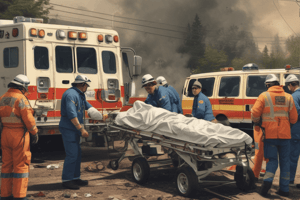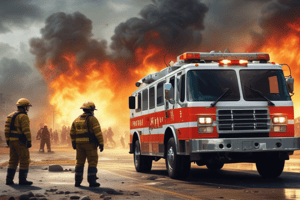Podcast
Questions and Answers
What is the first step for the dispatch when a mass casualty medical situation is identified?
What is the first step for the dispatch when a mass casualty medical situation is identified?
- Activate all reserve Fire Department rescues
- Determine the number of available helicopters
- Dispatch all available Fire Department rescues to the Staging Area (correct)
- Advise hospitals of the situation and patient numbers
Which hospitals should be contacted first during a mass casualty incident?
Which hospitals should be contacted first during a mass casualty incident?
- Hospitals nearest to the helicopter landing zone
- Level 2 facilities based on patient capacity
- Level 1 hospitals and specialty hospitals (correct)
- All hospitals in the vicinity regardless of level
What information should be relayed to hospitals during a mass casualty situation?
What information should be relayed to hospitals during a mass casualty situation?
- Expected time of arrival of patients being transported
- Location and approximate number of patients involved (correct)
- Exact number of patients sent to each hospital prior to transport
- Waiting times for patients once they arrive at the hospitals
What should be done after all patients have been transported?
What should be done after all patients have been transported?
In what scenario would City Buses be dispatched during a mass casualty event?
In what scenario would City Buses be dispatched during a mass casualty event?
What is the primary responsibility of the rescues once dispatched to the Staging Area?
What is the primary responsibility of the rescues once dispatched to the Staging Area?
Which communication should not be encouraged with hospitals during a mass casualty incident?
Which communication should not be encouraged with hospitals during a mass casualty incident?
When should private medical helicopters be activated during a mass casualty situation?
When should private medical helicopters be activated during a mass casualty situation?
During the notification process, which type of hospitals is prioritized for contact first?
During the notification process, which type of hospitals is prioritized for contact first?
What is the main function of the City Buses during a mass casualty event?
What is the main function of the City Buses during a mass casualty event?
Flashcards are hidden until you start studying
Study Notes
Notification Procedures for Medical Disaster
- Procedures are established for large scale mass casualty medical situations.
- Effective communication and coordination are critical among various entities involved in emergency response.
Rescues
- All available Fire Department rescue units must be dispatched to a designated Staging Area.
- Private ambulance companies should be engaged as necessary.
- Determine the estimated time of arrival (ETA) and availability of rescue units to inform Command.
- Activate reserve Fire Department rescues to bolster response efforts.
Helicopters
- Private medical helicopters and DPS Rangers should be placed on stand-by based on availability.
- Helicopter dispatch should occur upon request from Command.
- Ensure designated radio channels are communicated for efficient coordination with the Landing Zone.
Hospitals
- Notify hospitals and emergency centers about the incident specifics, including the location and expected patient volume.
- Direct hospitals to confirm their capacity without contacting the Dispatch Center.
- Level 1 hospitals and specialty facilities should be contacted first; Level 2 facilities follow based on geographic proximity.
- Gather real-time information on the ability of medical facilities to accept patients from hospitals.
- Notify hospitals according to specific capabilities related to the incident type (e.g., trauma, burns).
- Once patients are transported, confirm the number sent to each hospital and provide updates on total patients transported or enroute.
- Inform hospitals when no further patients are anticipated for transport, and convey updates as necessary.
City Buses
- Inquire with Command on the need for buses to assist in transport.
- Dispatch Phoenix Transit buses to the designated Level 2 staging area, ensuring that they are radio dispatched for coordination.
Notification Procedures for Medical Disaster
- Procedures are established for large scale mass casualty medical situations.
- Effective communication and coordination are critical among various entities involved in emergency response.
Rescues
- All available Fire Department rescue units must be dispatched to a designated Staging Area.
- Private ambulance companies should be engaged as necessary.
- Determine the estimated time of arrival (ETA) and availability of rescue units to inform Command.
- Activate reserve Fire Department rescues to bolster response efforts.
Helicopters
- Private medical helicopters and DPS Rangers should be placed on stand-by based on availability.
- Helicopter dispatch should occur upon request from Command.
- Ensure designated radio channels are communicated for efficient coordination with the Landing Zone.
Hospitals
- Notify hospitals and emergency centers about the incident specifics, including the location and expected patient volume.
- Direct hospitals to confirm their capacity without contacting the Dispatch Center.
- Level 1 hospitals and specialty facilities should be contacted first; Level 2 facilities follow based on geographic proximity.
- Gather real-time information on the ability of medical facilities to accept patients from hospitals.
- Notify hospitals according to specific capabilities related to the incident type (e.g., trauma, burns).
- Once patients are transported, confirm the number sent to each hospital and provide updates on total patients transported or enroute.
- Inform hospitals when no further patients are anticipated for transport, and convey updates as necessary.
City Buses
- Inquire with Command on the need for buses to assist in transport.
- Dispatch Phoenix Transit buses to the designated Level 2 staging area, ensuring that they are radio dispatched for coordination.
Studying That Suits You
Use AI to generate personalized quizzes and flashcards to suit your learning preferences.




